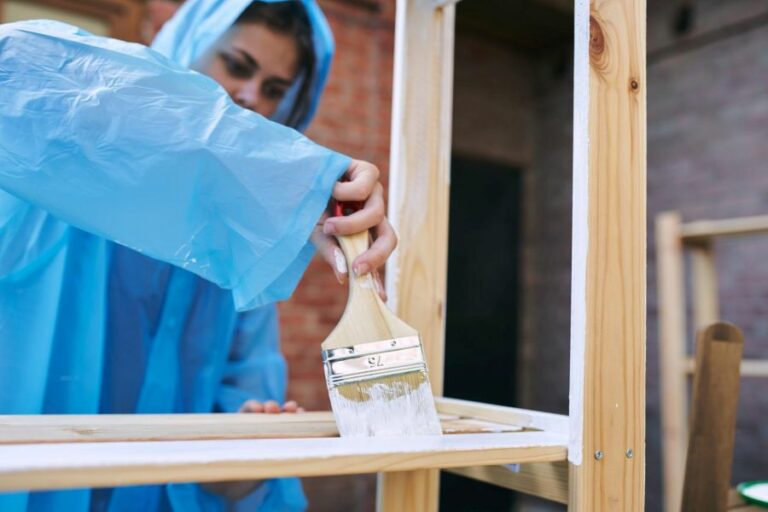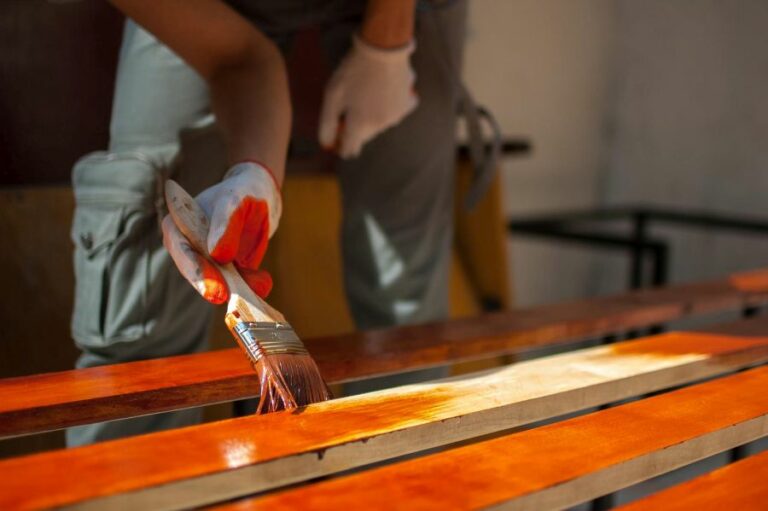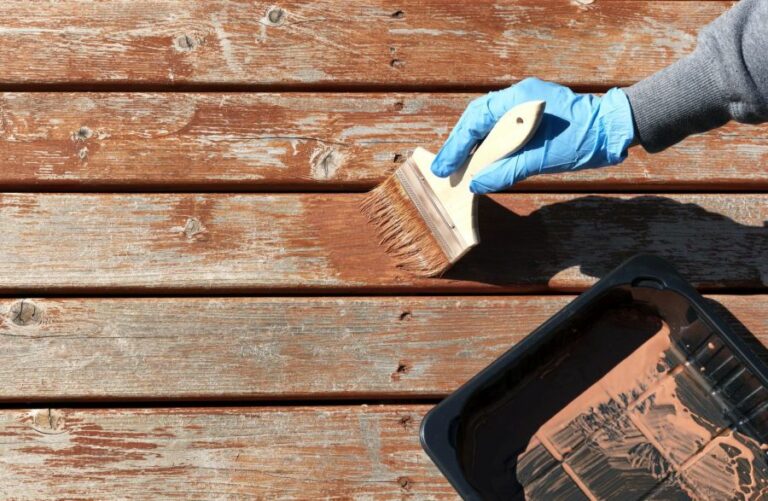Outdoor Stone Paint, 25 Things You Should Know
When it comes to transforming the appearance of your home or garden, outdoor stone paint can be a game-changer. Its versatility and durability make it a highly sought-after solution for DIY enthusiasts and professionals alike. But how do you choose the right one and apply it effectively?
Outdoor stone paint:
Outdoor stone paint is a specially formulated coating designed to enhance the appearance and protect stone surfaces in gardens, patios, and other outdoor spaces. It offers durability, aesthetics, weather and dirt protection, and easy maintenance. Masonry paint, textured paint, and concrete stain are popular options for various surfaces and finishes. Proper surface preparation, primer application, and multiple coats ensure a long-lasting, visually appealing result.

Discover the transformative power of outdoor stone paint! Achieve stunning curb appeal, refresh tired surfaces, and protect your masonry from wear and tear. Read on for expert tips, techniques, and top products to turn your stonework into a show-stopping masterpiece!
Contents
- 1 Exterior Stone Surface Paint
- 2 What is the Most Suitable Paint for Exterior Stone Surfaces?
- 3 What is the Appropriate Type of Paint for Outdoor Stone Surfaces?
- 4 Which Type of Paint is Suitable for Outdoor Patio Stones?
- 5 Identifying the Optimal Paint Choice for Stone Surfaces
- 6 Is it Possible to Obtain Paint that Resembles the Appearance of Stone?
Exterior Stone Surface Paint
Outdoor stone paints have become increasingly popular in recent years as people look to enhance the appearance of their gardens, patios, and other outdoor spaces. These paints are specially formulated to withstand harsh weather conditions and adhere effectively to stone surfaces.
• Types of Outdoor Stone Paint
There are several outdoor stone paint options available in the market, each catering to different requirements and preferences. Here are some of the most popular types:
– Masonry Paint
Masonry paint is specifically formulated for use on brick, stone, and other masonry surfaces. It provides a durable, weather-resistant layer that can help protect your stone surfaces from the elements while also improving their appearance.
This type of paint can be used on various outdoor surfaces like walls, fences, and statues. Masonry paint is available in both water-based and oil-based variants, each offering distinct pros and cons.
– Textured Paint
Textured paint is another popular option for outdoor stone surfaces, as it not only adds color but also creates a more natural, textured appearance. This can be particularly useful if you want to give a cohesive look to a space that includes both painted and natural stone.
It is often used on walls, pathways, and large stone features, offering slip resistance and the ability to hide imperfections.
– Concrete Stain
Concrete stain, although not technically a paint, is another option for those looking to enhance their outdoor stone surfaces. This product penetrates the stone surface, leaving a semi-transparent color that allows the natural texture and patterns of the stone to show through.
It is water-resistant and can withstand foot and vehicle traffic, making it suitable for pathways, driveways, and patios.
• The Benefits of Outdoor Stone Paint
Outdoor stone paint offers several key benefits that make it a popular choice among homeowners and professionals alike. Some of these benefits include:
– Durability
One of the primary reasons people opt for outdoor stone paint is its ability to provide a long-lasting finish that withstands harsh weather conditions. High-quality outdoor stone paint can protect your surfaces from fading, chipping, and peeling for years to come.
– Enhancing Aesthetics
Outdoor stone paint can significantly enhance the appearance of your garden or outdoor space. By selecting a color that complements the surrounding area, you can create a cohesive and visually appealing environment.
– Protection from Weather and Dirt
Outdoor stone paint can help protect your surfaces from the damaging effects of rain, snow, and extreme temperatures. It also provides a barrier against dirt and mildew, helping your stone surfaces stay clean and fresh over time.
– Easy Maintenance
Once your surfaces have been painted, maintaining them becomes much simpler. Most outdoor stone paint is easy to clean, requiring just a gentle wash with soap and water to keep it looking good as new.
• How to Select and Apply Outdoor Stone Paint
Choosing and applying the right outdoor stone paint for your needs is essential for achieving the desired result. Here are some crucial factors to consider when selecting an outdoor stone paint:
– The Surface Material
Different types of stone paints are suitable for different types of stone or masonry surfaces. Verify the paint’s compatibility with your materials before making a purchase. If in doubt, consult the manufacturer’s instructions or seek advice from a professional.
– The Finish
Consider whether you want a smooth or textured finish, as this will influence the type of paint you choose. Textured paint is recommended for areas where a more natural appearance or added grip is desirable, while smooth finishes may be more suitable for walls and fences.
– Color Selection
Take some time to choose a color that complements your outdoor space and creates the desired visual effect. You may wish to test a small area before committing to a full paint job, as the appearance of color can vary depending on factors like natural light and surrounding materials.
Applying the paint correctly is essential for a successful outcome. Here are a few key tips for applying outdoor stone paint:
Surface Preparation
Before starting, it’s vital to clean the surface thoroughly and remove any loose or flaking material, dirt, or debris. Using a pressure washer can be particularly effective for this purpose. Allow the surface to dry completely before moving on to the next step.
Primer
Applying a primer to your outdoor stone surface can help create a stronger bond between the paint and the surface, ensuring a longer-lasting finish. Choose a primer suited to your surface material and follow the manufacturer’s instructions for application.
Application Techniques
Outdoor stone paint can be applied using a variety of tools, including brushes, rollers, and paint sprayers. The choice of application method depends on personal preference, the type of paint being used, and the size and shape of the surface being painted.
Number of Coats
Wear and tear resistance can be improved by applying multiple coats of paint, allowing ample drying time between coats. Check the manufacturer’s recommendations for the number of coats required, as this can vary between products.
• In Conclusion
Outdoor stone paint is a versatile and practical solution for enhancing the appearance and longevity of stone surfaces in gardens, patios, and other outdoor spaces.
By understanding the different types available, making the right selection, and following the correct application procedures, you can enjoy a stunning, durable finish that will stand the test of time.
What is the Most Suitable Paint for Exterior Stone Surfaces?
Outdoor stone surfaces, such as patios, walkways, and walls, require durable and protective paint to withstand weather conditions, foot traffic, and the test of time. There are many options available for painting outdoor stone, but not all paints will give the long-lasting results you desire.
• Best Paint Types for Outdoor Stone Surfaces
– Acrylic Latex Paint
Acrylic latex paint is a popular choice for outdoor stone surfaces due to its excellent adhesion and durability. This water-based paint is easy to apply and clean up, and it dries quickly. It’s resistant to cracking, peeling, and blistering, so it’s ideal for lasting protection from the elements.
Acrylic latex paint can be found at most home improvement stores, and it comes in a wide range of colors and finishes.
– Masonry Paint
Specifically designed for use on concrete, brick, and outdoor stone surfaces, masonry paint is another excellent option to consider. This paint is formulated with high-quality ingredients that provide superior water resistance, protection against UV rays, and mold and mildew resistance.
Many masonry paints also have built-in primers, simplifying the painting process.
– Elastomeric Paint
Ideal for surfaces that require greater flexibility and durability, elastomeric paint is an excellent choice for outdoor stone in areas with extreme temperature fluctuations or prone to cracks. This paint forms a thick, rubber-like membrane that stretches with the surface to resist cracks and maintain waterproofing.
While it may be more expensive upfront, the long-term protection it provides can be a worthwhile investment.
• Preparing Outdoor Stone Surfaces for Painting
– Cleaning the Surface
Proper surface preparation is crucial for a successful outdoor stone painting project. First, clean the surface thoroughly to remove dirt, mold, and mildew. A pressure washer is a popular choice for this task, especially for large or heavily stained surfaces.
Alternatively, a mixture of warm water and mild detergent can be used to scrub the surface with a stiff-bristled brush.
– Repairing Cracks and Damaged Areas
Inspect the stone surface for cracks, holes, or damaged areas that need repair before painting. Use a suitable exterior filler or patching product to fill and smooth these areas. Allow the repairs to dry fully before proceeding to the next step.
– Application of Primer (if necessary)
While some masonry or elastomeric paints include built-in primers, it’s important to determine if your chosen paint requires a separate primer before application. Priming the outdoor stone surface will help the paint adhere better and prolong its longevity.
Be sure to use a high-quality, exterior-grade primer compatible with the chosen paint.
• Application Tips for Outdoor Stone Paint
– Use the Right Tools
High-quality paint brushes, rollers, or sprayers are essential for a successful outdoor stone painting project. Choose the appropriate brush or roller for the paint type and the texture of the stone surface.
For textured surfaces, a masonry roller or a sprayer may be the best option to ensure paint reaches all surface areas.
– Apply in Appropriate Weather Conditions
Outdoor painting should ideally be done in dry, mild weather conditions. Heavy rainfall or extreme temperatures can negatively impact paint adhesion and drying time. It’s recommended to check the weather forecast and choose a time with several consecutive days of favorable conditions.
– Apply Multiple Coats
Several coats of paint may be necessary for full coverage and protection of the outdoor stone surface. Follow the manufacturer’s instructions for drying time between coats to ensure proper adhesion and a professional-looking finish.
• Maintenance Tips for Painted Outdoor Stone Surfaces
Once your outdoor stone surface has been painted, regular maintenance can help prolong the life and appearance of the paint. Here are some simple tips to keep in mind:
- Periodically clean the painted stone surface with warm water and a mild detergent solution to remove dirt and prevent mold or mildew buildup.
- Inspect the painted surface yearly for cracks, peeling, or other paint damage. Repair and touch up as needed.
- Avoid using harsh chemicals on the painted stone surface that could damage or strip the paint.
- Protect the painted surface from excessive moisture, such as overhanging tree branches that can deposit water or plant debris. Keep the area around the painted stone free from debris and foliage to allow proper airflow and prevent moisture buildup.
In conclusion, selecting the best paint for outdoor stone means considering the specific needs of your surface, proper surface preparation, and understanding the paint’s application requirements.
By investing time and effort in choosing the right paint and following the tips provided, you can enjoy a beautiful, lasting outdoor stone surface that adds charm and value to your property.
What is the Appropriate Type of Paint for Outdoor Stone Surfaces?
In this comprehensive guide, we will discuss the various aspects of painting outdoor stone surfaces, including the types of paint to use, the steps involved in preparing the surface, application techniques, and maintaining your painted stone over time.
• Choosing the Right Paint for Outdoor Stone
When it comes to painting outdoor stone surfaces, it is essential to choose the right type of paint to ensure durability, weather resistance, and a professional finish. The two main types of paint suitable for outdoor stone surfaces are:
– Masonry Paint
Masonry paint is a water-based paint specifically designed for use on concrete, brick, and stone surfaces. It is incredibly durable, weather-resistant, and helps protect the stone from the elements.
Masonry paint is available in a wide range of colors, allowing you to choose a shade that will complement the surrounding area.
– Mineral-Based Paint
Mineral-based paint, also known as silicate paint or mineral paint, is another popular choice for outdoor stone. This type of paint is made using a combination of natural minerals and inorganic pigments, creating a durable and long-lasting finish.
Mineral-based paint is particularly well-suited to older stone surfaces, as it allows the stone to “breathe” and does not trap moisture.
• Preparing the Stone Surface
Before you begin painting, it is crucial to properly prepare the surface for the best possible results. The following steps are recommended for preparing your outdoor stone for painting:
- Clean the Surface: Thoroughly clean the stone surface to remove dirt, dust, and debris. You can use a scrubbing brush with mild detergents or a pressure washer for particularly dirty surfaces.
- Repair Damaged Areas: Inspect the stone for any cracks, chips, or holes and repair them using an appropriate filler or masonry repair compound.
- Apply a Primer (Optional): Although not always necessary, applying a primer to the stone surface can help improve paint adhesion and coverage. If you are painting a particularly porous stone or transitioning from a dark color to a lighter color, using a primer is recommended.
- Allow the Surface to Dry: Ensure the stone is completely dry before you begin painting. Depending on the local climate and the stone’s porosity, drying times may vary, but it is essential to wait until the surface is free of any trapped moisture.
• Application Techniques
Now that your surface is prepared, it is time to apply your chosen paint. Follow these steps for seamless results:
- Choose the Right Tools: For outdoor stone surfaces, using a high-quality, long-napped roller or a masonry brush is recommended. These tools help ensure even paint coverage and better penetration into the stone’s texture.
- Stir the Paint Thoroughly: Be sure to mix the paint well before beginning, as this ensures an even distribution of color and ingredients throughout the paint.
- Apply the Paint in Thin, Even Coats: It is essential to apply the paint in thin, even coats rather than attempting to cover the surface with a single thick coat. This helps prevent issues with paint coverage, such as streaking, uneven color, or paint cracking. Allow each coat to dry thoroughly before applying the next.
- Use Proper Technique: When applying the paint, use long, even strokes and try to maintain a “wet edge” to prevent lap marks. Make sure to fully cover any areas where the primer may be showing through.
• Maintaining Your Painted Stone
To keep your freshly painted outdoor stone looking its best for years to come, follow these maintenance tips:
- Clean Regularly: Keeping your stone surface clean helps prevent dirt and algae buildup, which can cause discoloration or paint degradation.
- Inspect for Damage: Periodically inspect your painted stone for any signs of damage or wear, such as fading, chipping, or cracks. Address any issues as soon as possible to maintain the integrity of the paint and prevent further damage.
- Reapply Paint as Needed: Depending on the paint you choose and the environmental conditions, you may need to reapply the paint every few years to refresh and maintain its appearance.
By following the guidelines and recommendations provided in this guide, you can effectively paint your outdoor stone surfaces, adding beauty and durability to your home’s exterior or garden.
With the proper preparation, application, and maintenance, your painted stone will serve as an attractive feature for years to come.
Product | Type | Description |
|---|---|---|
Masonry Paint | Water-based | Designed to adhere to stone and brick, provides a protective and breathable barrier. |
Acrylic Latex Paint | Water-based | Flexible finish, resistant to cracking and peeling, suitable for various surfaces, including stone. |
Lime Wash | Mineral-based | Natural and breathable finish, allows moisture to escape, giving an aged look to the stone. |
Silicone Masonry Paint | Water-based | Water-repellent and breathable, provides long-lasting protection and color retention. |
Mineral-Based Paint | Mineral-based | Highly breathable and durable, chemically bonds with stone and is resistant to mold and algae growth. |
Which Type of Paint is Suitable for Outdoor Patio Stones?
Painting your outdoor patio stones is a great way to refresh and customize your outdoor space. However, choosing the right type of paint can be a daunting task.
• Acrylic Latex Paints: Best for Versatility and Longevity
Acrylic latex paints are an excellent choice for outdoor patio stones because of their durability, flexibility, and resistance to the elements. This type of paint forms a tough, flexible film that adheres well to a variety of surfaces, including masonry and concrete.
Plus, acrylic latex paints are resistant to fading, cracking, and peeling, making them perfect for withstanding harsh outdoor conditions.
One brand that has earned a solid reputation for being specifically designed for outdoor patio stones and other similar surfaces is BEHR. I recommend Behr Premium Porch & Patio Floor Paint as it’s designed to withstand the varying weather conditions and heavy foot traffic outdoor patios often experience.
• Epoxy Paints: Best for Resistance to Stains and Wear
Epoxy paints provide a hard, durable surface that is highly resistant to stains and wear, making them an excellent choice for outdoor patio stones, especially in high-traffic areas.
This type of paint is also resistant to water, chemicals, and UV radiation, which is essential when painting outdoor surfaces that will be exposed to the elements.
One product to consider for your outdoor patio stones is Rust-Oleum’s EPOXYShield. This epoxy paint provides a highly durable and long-lasting finish, helping to maintain their appearance for years to come.
• Tips for Choosing the Right Outdoor Patio Stone Paint
– Color Selection
When selecting a color for your outdoor patio stones, consider the overall aesthetic of your home and landscaping. Choose a color that complements or contrasts with the surroundings.
You may also want to consider colors that help to hide dirt and stains, as well as those that will not show signs of wear as quickly.
– Look for High-Quality, Weather-Resistant Paints
Choose a high-quality paint specifically designed for outdoor use. Look for products that indicate they are weather-resistant to ensure the paint can withstand varying temperatures, moisture levels, and sunlight exposure without deteriorating.
– Consider a Higher Gloss Finish
Paints with a glossier finish tend to be more resistant to dirt, stains, and wear, making them ideal for outdoor patio stones. A higher gloss finish can also give a more polished and well-maintained appearance to your patio area.
• Preparing Your Outdoor Patio Stones for Paint
Before diving into painting your outdoor patio stones, you must properly prepare the surface. This preparation will ensure your paint adheres correctly and maintains a long-lasting, professional-looking finish.
- Thoroughly clean the surface: Use a pressure washer or a stiff brush with water and mild detergent to remove dirt, grime, and loose debris. Allow the surface to dry completely before proceeding.
- Repair any damage: Cracks, chips, and other imperfections should be repaired with a suitable patching compound or filler. This step will provide a smooth surface more conducive to paint adhesion.
- Apply a primer (if necessary): Some paints may require a primer for optimal adhesion and performance. Be sure to follow the manufacturer’s recommendations on primer usage.
• Application Tips for a Successful Outcome
- Follow the manufacturer’s recommendations: Each paint brand may have specific instructions for application, which should be followed to ensure the best results. This information may include temperature and weather conditions to avoid, drying times, and the number of recommended coats.
- Apply thin, even layers of paint: Applying thin, even layers of paint will prevent drips and ensure uniform coverage. Allow each layer to dry before applying the next coat.
- Use the right tools: Use brushes or rollers specifically designed for the type of paint you are using. These tools will help to ensure the desired application and finish.
- Protect the surrounding area: Use painter’s tape and drop cloths to protect your patio’s surrounding elements, such as plants or furniture, from paint splatter.
By following the recommendations and steps outlined in this comprehensive guide, you’ll be well on your way to selecting the perfect paint for your outdoor patio stones and achieving a professional, long-lasting finish.
For more information on outdoor patio stone care and maintenance, visit the Interlocking Concrete Pavement Institute‘s website, a non-profit organization dedicated to the advancement of knowledge and education in the hardscape industry.
Identifying the Optimal Paint Choice for Stone Surfaces
Stone surfaces are not only durable but also provide an elegant appearance for both indoor and outdoor spaces. However, over time, these surfaces may become weathered or stained, making it necessary to paint them to restore their original appearance.
Choosing the right paint for stone surfaces can be a challenging task, as there are numerous options available on the market.
• The Importance of Surface Preparation
Before discussing the best paint for stone, it’s crucial to highlight the importance of proper surface preparation. This step plays a significant role in determining the longevity and effectiveness of the paint application.
To prepare a stone surface for painting, you should start by cleaning it thoroughly to remove any dust, dirt, or debris. You can use a brush or a power washer for outdoor surfaces. If there are any cracks, holes, or weak spots in the stone, it’s essential to repair or fill them using a suitable filler.
Once the surface is clean and dry, you can then proceed with the painting process.
• Types of Paint for Stone Surfaces
There are various types of paint suitable for use on stone surfaces, each with its advantages and disadvantages. Let’s take a closer look at some of the most popular options:
– Acrylic Latex Paint
Acrylic latex paint is a popular choice for painting stone surfaces due to its ease of application, durability, and versatility. This water-based paint dries quickly and provides excellent adhesion to stone surfaces, making it an ideal option for both indoor and outdoor applications.
Acrylic latex paint is also resistant to fading, cracking, and peeling, ensuring that your stone surface maintains its fresh appearance for an extended period. Additionally, it’s available in various finishes, including flat, satin, and gloss, meaning you can choose the level of shine that best suits your space.
When selecting acrylic latex paint for a stone surface, it’s essential to choose a high-quality product specifically formulated for masonry or stone applications, such as Benjamin Moore’s Regal Select or Sherwin Williams’ Loxon.
– Elastomeric Paint
Elastomeric paint is another suitable option for stone surfaces, particularly for outdoor applications. This type of paint contains elastic polymers, which allow it to expand and contract with temperature changes.
This characteristic makes elastomeric paint incredibly resistant to cracking and peeling, ensuring a long-lasting finish on your stone surface.
In addition to its durability, elastomeric paint also provides excellent water resistance, making it an ideal choice for stone surfaces exposed to moisture, such as retaining walls, fountains, or garden statues.
However, this type of paint tends to be more expensive than acrylic latex paint, and its application may require more skill and expertise.
– Mineral-Based Paint
Mineral-based paint, also known as silicate paint, is a unique option for stone surfaces, as it chemically bonds to the surface, creating a virtually inseparable layer.
This type of paint is incredibly durable, resistant to fading and weathering, and provides excellent breathability, allowing moisture to escape the stone surface while preventing water penetration.
Mineral-based paint is particularly well-suited for historical buildings or monuments, as it allows the stone to maintain its natural appearance while providing long-lasting protection. However, this type of paint can be more challenging to apply and is generally more expensive than other options.
One reputable brand to consider for mineral-based paint is KEIM’s Soldalit- a water-based, sol-silicate exterior paint.
• Application Techniques and Tools
When painting a stone surface, it’s essential to use the appropriate application technique and tools. For the best results, follow these recommendations:
- Use a high-quality brush or roller specifically designed for masonry or stone surfaces, as these tools will help ensure even coverage and a smoother finish.
- Apply a primer before painting, particularly when using acrylic latex or elastomeric paint. A high-quality masonry primer will improve adhesion and help seal the porous surface, resulting in a more durable finish.
- Apply multiple coats of paint, allowing each coat to dry thoroughly before applying the next one. This method will ensure optimal coverage and durability of the paint.
• Conclusion
Selecting the best paint for a stone surface depends on your specific requirements, such as the environment in which the surface is located, your budget, and your desired appearance.
Acrylic latex paint, elastomeric paint, and mineral-based paint are all viable options, each with its unique advantages and considerations.
Regardless of the paint type you choose, proper surface preparation and application techniques are crucial to achieving a durable, long-lasting finish.
By following the recommendations in this article, you can successfully paint and protect your stone surfaces, ensuring they maintain their elegance and beauty for years to come.
Paint Type | Brand | Description |
|---|---|---|
Masonry Paint | Dulux Weathershield Smooth Masonry Paint | A water-based paint specifically designed to provide long-lasting protection for exterior stone surfaces. |
Acrylic Latex Paint | BEHR Premium Plus | A high-quality acrylic latex paint suitable for both interior and exterior stone surfaces, providing excellent durability and adhesion. |
Mineral-Based Paint | KEIM Mineral Paints | A range of silicate-based paints that chemically bond with the stone surface, providing a highly durable and water-resistant finish. |
Direct-to-Metal Paint | Rust-Oleum Stops Rust | A versatile paint suitable for a variety of surfaces, including stone, offering excellent resistance to weathering and rust. |
Elastomeric Paint | Valspar Duramax | A high-performance paint with a flexible, waterproof coating that expands and contracts with temperature changes to prevent cracking and peeling on stone surfaces. |
Is it Possible to Obtain Paint that Resembles the Appearance of Stone?
Achieving the appearance of natural stone on your walls, floors, or furniture has never been easier with paint that looks like stone.
Stone-effect paints have taken the world of interior design by storm, offering an attractive, durable, and cost-effective solution to people who desire a chic and rustic stone finish for their space.
• Types Of Paint That Mimic Stone
Manufacturers have developed different types of paint that can effectively replicate the texture and appearance of the stone. Depending on your preferences and application requirements, you can choose from the following options:
1. Textured Paint
Textured paint is a pre-mixed solution that consists of fine granules or aggregate, which creates an illusion of depth and roughness, resembling a stone surface. With a variety of colors and textures available, textured paint is ideal for both indoor and outdoor applications.
2. Decorative Paint Finishes
Decorative paint finishes like faux stone or sandstone use multiple layers and glaze to achieve a convincing stone-like effect. These paints are often applied using special tools such as sponges, rags, or brushes to create intricate patterns, veins, and marbling effects that resemble natural stone formations.
3. Stone-effect Spray Paint
Stone-effect spray paint is an aerosol product that delivers a quick and easy way to achieve a natural stone appearance on different surfaces like plastic, wood, and metal. The spray paint emits fine particles, creating a textured finish that emulates stone.
• Choosing The Right Stone-Effect Paint And Color
When selecting a paint that looks like stone, it’s important to consider factors such as the desired finish, application surface, and durability requirements. Here are a few tips to help you make an informed decision:
- Match with the overall decor: Choose a stone-effect paint that complements the existing colors, textures, and style of your space. For example, if you have a modern interior with sleek surfaces, consider subtle and smooth-textured paint in a neutral color. On the other hand, if you want to emulate a rustic or natural setting, opt for paint with a rougher texture and earthy tones.
- Select the appropriate paint type: Depending on the surface you’ll be painting, some stone-effect paints may not be suitable. Always consult the manufacturer’s instructions to ensure that the paint is compatible with the material you’ll be applying it.
- Consider durability and maintenance: High-traffic areas or surfaces exposed to moisture and direct sunlight may require a more durable, water-resistant, and UV-stabilized paint. Additionally, textured paint finishes may accumulate dust and dirt over time, so it’s essential to select a paint that can be easily cleaned and maintained.
• Application Techniques For A Convincing Stone Look
Proper application is key to achieving a realistic and long-lasting stone effect. Here are some expert tips for getting it right:
- Prepare the surface: Clean and repair the surface before applying the paint. Remove any dust, dirt, or grease, and fill in cracks, holes, or dents. Make sure the surface is dry before starting the painting process.
- Apply a primer: Using a primer helps to provide better adhesion and coverage, ensuring your stone-effect paint lasts longer and looks more professional.
- Experiment with different techniques: Depending on the type of stone-effect paint you’re using, there might be specific techniques to achieve the desired finish. Experiment with different tools and methods, sponging, rag-rolling, dry brushing, or stippling, to achieve a natural-looking texture.
- Layering: Build up multiple layers of paint, especially when using decorative paint finishes, to create depth and dimension that closely resembles natural stone.
- Seal and protect: Once the paint is completely dry, consider applying a sealer or varnish to protect your new stone-effect surface from wear and tear or moisture damage.
• Caring For Your Stone-Effect Painted Surface
To ensure the longevity and beauty of your stone-effect paint, follow these simple maintenance tips:
- Clean regularly: Dust and clean your painted surface using a soft brush or cloth. For textured finishes, you may need to use a vacuum cleaner with a soft brush attachment to remove dust from the crevices.
- Avoid harsh chemicals: When cleaning, avoid using abrasive or harsh chemicals, as they may damage the paint finish. Instead, use a gentle cleaner or mild soap and water to clean the surface.
- Address damage promptly: If you notice any chips, cracks, or signs of wear, it’s important to address these issues promptly. Touch up the paint as needed to maintain the look and protect the surface from further damage.
Paint that looks like stone is a versatile and affordable solution for those looking to bring the beauty of natural stone into their living spaces.
By carefully selecting the right type and color, mastering application techniques, and properly caring for your painted surfaces, you can enjoy a realistic and long-lasting stone effect that elevates your interior design.
Product Name | Description | Price |
|---|---|---|
Stone Finish Paint | This paint provides a natural stone-like finish on surfaces | $40 |
Granite Spray Paint | A spray paint that creates a granite-like texture and appearance | $15 |
Faux Stone Wall Paint | A paint that replicates the visual appeal of a stone wall | $45 |







